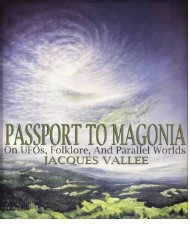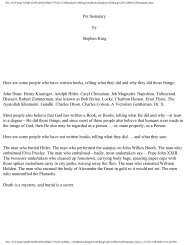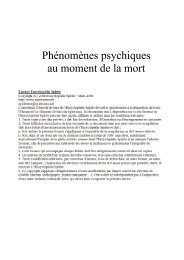extraordinary%20encounters
extraordinary%20encounters
extraordinary%20encounters
You also want an ePaper? Increase the reach of your titles
YUMPU automatically turns print PDFs into web optimized ePapers that Google loves.
70 Contactees<br />
nessed something that, whatever else it may or<br />
may not have been, was not a meteor. Observers<br />
would describe it as resembling a huge<br />
bullet-shaped object with batlike wings and a<br />
searchlight that it occasionally swept over the<br />
ground. Dark, except for two red lights along<br />
its side, it stayed in view for an hour and a<br />
half, moving at both slow and fast speeds.<br />
During the sighting, Probert phoned<br />
Layne, who urged him to see if the craft’s occupants<br />
were interested in a telepathic exchange.<br />
According to Probert, the experiment<br />
succeeded. The crew members revealed themselves<br />
as peaceful people with lightweight, illuminated<br />
bodies. They had been trying to<br />
contact earthlings for many years. Though<br />
they were afraid to land openly, they would<br />
meet with scientists in some isolated area or<br />
on a mountaintop. They had mastered antigravity,<br />
and their ship was called the Kareeta.<br />
The San Diego Union carried a humorous<br />
piece on the sighting, including Probert’s assertions,<br />
in its October 18 issue.<br />
The UFO age began the next year with<br />
p r i vate pilot Kenneth Arnold’s June 24 sighting<br />
of nine shiny objects that the press would<br />
soon call “flying saucers.” In the wake of<br />
A r n o l d’s re p o rt, many other people came forw<br />
a rd to recount their own encounters with<br />
u n k n own aerial phenomena. Among the<br />
most outlandish claims to see print was one<br />
told by Ole J. Sneide. In a letter to the Sa n<br />
Francisco Chro n i c l e appearing in the July 3<br />
issue, Sneide stated that the flying discs, also<br />
k n own as flying saucers, we re spaceships fro m<br />
other planets. (This is one of the ve ry earliest<br />
public attempts to link the new public sensation<br />
with extraterrestrial visitors. Nearly all<br />
other speculation held the saucers to be natural<br />
phenomena or advanced terrestrial aircraft.<br />
The association of flying saucers as<br />
spaceships did not take widespread hold until<br />
the early to mid-1950s.) Sneide also said the<br />
saucers had a base on the dark side of the<br />
moon. He knew as much because he re g u l a r l y<br />
t e l e p o rted himself around the galaxy. A foll<br />
ow-up article in the C h ro n i c l e d e t e r m i n e d<br />
that Sneide, a student of occultism, was seri-<br />
ous. Though nothing more is known about<br />
Sneide, he may have been something of a<br />
contactee before the word and concept had<br />
come into curre n c y.<br />
The contact movement, however, did not<br />
emerge into cultural visibility until January<br />
1952, when aircraft mechanic George W. Van<br />
Tassel began holding open weekly meetings in<br />
the high-desert country of southern California.<br />
At these gatherings Van Tassel would<br />
channel messages from starship (“ventla”)<br />
commanders, introducing, among others, the<br />
destined-to-be ubiquitous Ashtar. That same<br />
year, Van Tassel published I Rode a Flying<br />
Saucer!, the first modern contactee book (albeit<br />
with a misleading title; it would not be<br />
until the next year that Van Tassel would<br />
claim his first physical contact and spaceshipboarding).<br />
The year 1952 saw a flurry of contact<br />
activity. In Prescott, Arizona, George<br />
Hunt Williamson, his wife, Betty, and companions<br />
were communicating with Martians,<br />
Uranians, and other extraterrestrials from the<br />
solar system via ouija board, radio, and mental<br />
telepathy. In July, in the Nevada desert,<br />
Truman Bethurum met the crew of a “scow”<br />
from the planet Clarion, invisible to earthly<br />
eyes because it is always on the opposite side<br />
of the sun from Earth.<br />
Though arguably Van Tassel was the most<br />
i n fluential of the first generation of contactees,<br />
the most famous was George Ad a m s k i .<br />
Adamski had a long history in California—<br />
going back to the 1930s—as a kind of minor<br />
g u ru. When flying saucers rose to pro m i n e n c e<br />
in the late 1940s, Adamski produced photographs<br />
of spaceships in the atmosphere and<br />
near the moon. On November 20, 1952, accompanied<br />
by six associates, including Ge o r g e<br />
Hunt Williamson, he went out into the desert<br />
to meet a landed saucer and its pilot, a blondh<br />
a i red, angelic fig u re whom Adamski would<br />
call Orthon. Adamski went on to write books,<br />
l e c t u re all over the world, and become the<br />
single most controversial saucer personality of<br />
the 1950s. Though despised by conserva t i ve<br />
ufologists, who charged that his accounts of<br />
meetings with Venusians, Ma rtians, and Sa t u r-





